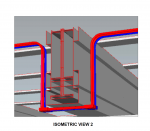Alwayslearningelec
Senior Member
- Location
- NJ
- Occupation
- Estimator
So we have a long run of a few conduits with no other routing available. We have about 20 of these beams we have to wrap that are in the run. I suggested running the conduits of threaded rod at a height right below the bottom of the beam but they want us to run tight to the slab so we have to wrap the beams. No other easier/cheaper way to do this besides wrapping with LB's? It's 1" EMT conduit. Thanks.


